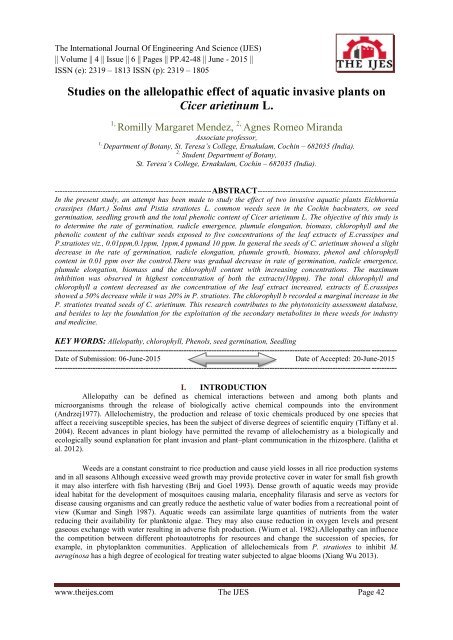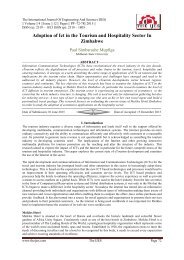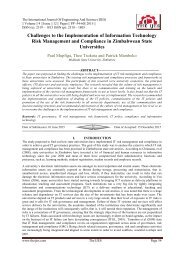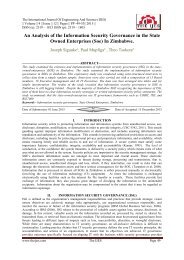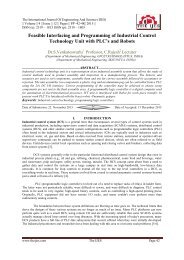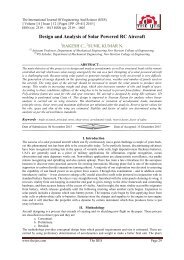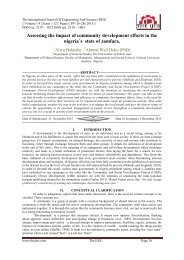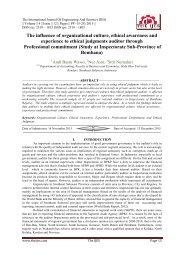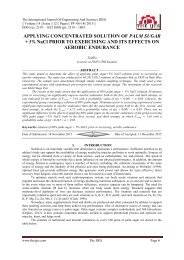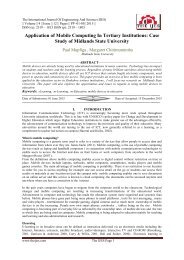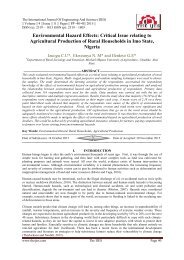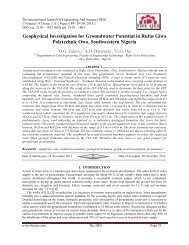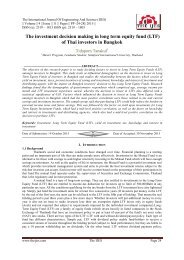Studies on the allelopathic effect of aquatic invasive plants on Cicer arietinum L.
You also want an ePaper? Increase the reach of your titles
YUMPU automatically turns print PDFs into web optimized ePapers that Google loves.
The Internati<strong>on</strong>al Journal Of Engineering And Science (IJES)<br />
|| Volume || 4 || Issue || 6 || Pages || PP.42-48 || June - 2015 ||<br />
ISSN (e): 2319 – 1813 ISSN (p): 2319 – 1805<br />
<str<strong>on</strong>g>Studies</str<strong>on</strong>g> <strong>on</strong> <strong>the</strong> <strong>allelopathic</strong> <strong>effect</strong> <strong>of</strong> <strong>aquatic</strong> <strong>invasive</strong> <strong>plants</strong> <strong>on</strong><br />
<strong>Cicer</strong> <strong>arietinum</strong> L.<br />
1,<br />
Romilly Margaret Mendez, 2, Agnes Romeo Miranda<br />
Associate pr<strong>of</strong>essor,<br />
1,<br />
Department <strong>of</strong> Botany, St. Teresa’s College, Ernakulam, Cochin – 682035 (India).<br />
2, Student , Department <strong>of</strong> Botany,<br />
St. Teresa’s College, Ernakulam, Cochin – 682035 (India).<br />
--------------------------------------------------------------ABSTRACT-------------------------------------------------------<br />
In <strong>the</strong> present study, an attempt has been made to study <strong>the</strong> <strong>effect</strong> <strong>of</strong> two <strong>invasive</strong> <strong>aquatic</strong> <strong>plants</strong> Eichhornia<br />
crassipes (Mart.) Solms and Pistia stratiotes L. comm<strong>on</strong> weeds seen in <strong>the</strong> Cochin backwaters, <strong>on</strong> seed<br />
germinati<strong>on</strong>, seedling growth and <strong>the</strong> total phenolic c<strong>on</strong>tent <strong>of</strong> <strong>Cicer</strong> <strong>arietinum</strong> L. The objective <strong>of</strong> this study is<br />
to determine <strong>the</strong> rate <strong>of</strong> germinati<strong>on</strong>, radicle emergence, plumule el<strong>on</strong>gati<strong>on</strong>, biomass, chlorophyll and <strong>the</strong><br />
phenolic c<strong>on</strong>tent <strong>of</strong> <strong>the</strong> cultivar seeds exposed to five c<strong>on</strong>centrati<strong>on</strong>s <strong>of</strong> <strong>the</strong> leaf extracts <strong>of</strong> E.crassipes and<br />
P.stratiotes viz., 0.01ppm,0.1ppm, 1ppm,4 ppmand 10 ppm. In general <strong>the</strong> seeds <strong>of</strong> C. <strong>arietinum</strong> showed a slight<br />
decrease in <strong>the</strong> rate <strong>of</strong> germinati<strong>on</strong>, radicle el<strong>on</strong>gati<strong>on</strong>, plumule growth, biomass, phenol and chlorophyll<br />
c<strong>on</strong>tent in 0.01 ppm over <strong>the</strong> c<strong>on</strong>trol.There was gradual decrease in rate <strong>of</strong> germinati<strong>on</strong>, radicle emergence,<br />
plumule el<strong>on</strong>gati<strong>on</strong>, biomass and <strong>the</strong> chlorophyll c<strong>on</strong>tent with increasing c<strong>on</strong>centrati<strong>on</strong>s. The maximum<br />
inhibiti<strong>on</strong> was observed in highest c<strong>on</strong>centrati<strong>on</strong> <strong>of</strong> both <strong>the</strong> extracts(10ppm). The total chlorophyll and<br />
chlorophyll a c<strong>on</strong>tent decreased as <strong>the</strong> c<strong>on</strong>centrati<strong>on</strong> <strong>of</strong> <strong>the</strong> leaf extract increased, extracts <strong>of</strong> E.crassipes<br />
showed a 50% decrease while it was 20% in P. stratiotes. The chlorophyll b recorded a marginal increase in <strong>the</strong><br />
P. stratiotes treated seeds <strong>of</strong> C. <strong>arietinum</strong>. This research c<strong>on</strong>tributes to <strong>the</strong> phytotoxicity assessment database,<br />
and besides to lay <strong>the</strong> foundati<strong>on</strong> for <strong>the</strong> exploitati<strong>on</strong> <strong>of</strong> <strong>the</strong> sec<strong>on</strong>dary metabolites in <strong>the</strong>se weeds for industry<br />
and medicine.<br />
KEY WORDS: Allelopathy, chlorophyll, Phenols, seed germinati<strong>on</strong>, Seedling<br />
----------------------------------------------------------------------------------------------------------------------------- ----------<br />
Date <strong>of</strong> Submissi<strong>on</strong>: 06-June-2015<br />
Date <strong>of</strong> Accepted: 20-June-2015<br />
----------------------------------------------------------------------------------------------------------------------------- ----------<br />
I. INTRODUCTION<br />
Allelopathy can be defined as chemical interacti<strong>on</strong>s between and am<strong>on</strong>g both <strong>plants</strong> and<br />
microorganisms through <strong>the</strong> release <strong>of</strong> biologically active chemical compounds into <strong>the</strong> envir<strong>on</strong>ment<br />
(Andrzej1977). Allelochemistry, <strong>the</strong> producti<strong>on</strong> and release <strong>of</strong> toxic chemicals produced by <strong>on</strong>e species that<br />
affect a receiving susceptible species, has been <strong>the</strong> subject <strong>of</strong> diverse degrees <strong>of</strong> scientific enquiry (Tiffany et al.<br />
2004). Recent advances in plant biology have permitted <strong>the</strong> revamp <strong>of</strong> allelochemistry as a biologically and<br />
ecologically sound explanati<strong>on</strong> for plant invasi<strong>on</strong> and plant–plant communicati<strong>on</strong> in <strong>the</strong> rhizosphere. (lalitha et<br />
al. 2012).<br />
Weeds are a c<strong>on</strong>stant c<strong>on</strong>straint to rice producti<strong>on</strong> and cause yield losses in all rice producti<strong>on</strong> systems<br />
and in all seas<strong>on</strong>s Although excessive weed growth may provide protective cover in water for small fish growth<br />
it may also interfere with fish harvesting (Brij and Goel 1993). Dense growth <strong>of</strong> <strong>aquatic</strong> weeds may provide<br />
ideal habitat for <strong>the</strong> development <strong>of</strong> mosquitoes causing malaria, encephality filarasis and serve as vectors for<br />
disease causing organisms and can greatly reduce <strong>the</strong> aes<strong>the</strong>tic value <strong>of</strong> water bodies from a recreati<strong>on</strong>al point <strong>of</strong><br />
view (Kumar and Singh 1987). Aquatic weeds can assimilate large quantities <strong>of</strong> nutrients from <strong>the</strong> water<br />
reducing <strong>the</strong>ir availability for plankt<strong>on</strong>ic algae. They may also cause reducti<strong>on</strong> in oxygen levels and present<br />
gaseous exchange with water resulting in adverse fish producti<strong>on</strong>. (Wium et al. 1982).Allelopathy can influence<br />
<strong>the</strong> competiti<strong>on</strong> between different photoautotrophs for resources and change <strong>the</strong> successi<strong>on</strong> <strong>of</strong> species, for<br />
example, in phytoplankt<strong>on</strong> communities. Applicati<strong>on</strong> <strong>of</strong> allelochemicals from P. stratiotes to inhibit M.<br />
aeruginosa has a high degree <strong>of</strong> ecological for treating water subjected to algae blooms (Xiang Wu 2013).<br />
www.<strong>the</strong>ijes.com The IJES Page 42
<str<strong>on</strong>g>Studies</str<strong>on</strong>g> <strong>on</strong> <strong>the</strong> Allelopathic <strong>effect</strong> <strong>of</strong> <strong>aquatic</strong> <strong>invasive</strong> <strong>plants</strong> On <strong>Cicer</strong><strong>arietinum</strong> L.<br />
Our increasing knowledge <strong>of</strong> allelopathy helps greatly in our understanding <strong>of</strong> many ecological<br />
phenomena, such as successi<strong>on</strong> and patterning <strong>of</strong> agroecosystems. Research has been particularly active in<br />
relati<strong>on</strong> to <strong>the</strong> roles <strong>of</strong> allelopathy in agriculture. The basic approach used in <strong>allelopathic</strong> research for<br />
agricultural crops has been to screen both crop <strong>plants</strong> and natural vegetati<strong>on</strong> for <strong>the</strong>ir capacity to suppress weeds<br />
(Jeffers<strong>on</strong> and Pennacchio 2003). To dem<strong>on</strong>strate allelopathy, plant origin, producti<strong>on</strong>, and identificati<strong>on</strong> <strong>of</strong><br />
allelochemicals must be established as well as persistence in <strong>the</strong> envir<strong>on</strong>ment over time in c<strong>on</strong>centrati<strong>on</strong>s<br />
sufficient to affect plant species (Hesammi and Farshidi 2012). Allelopathy may be a key mechanism by which<br />
some native trees could reduce <strong>the</strong> abundance and impact <strong>of</strong> exotic species. It is a recognized tool for weed<br />
management in agriculture and agr<strong>of</strong>orestry (Cummings et al. 2012).<br />
<strong>Cicer</strong> <strong>arietinum</strong> L. also known as chickpea is an important pulse crop with a diverse array <strong>of</strong> potential nutriti<strong>on</strong>al<br />
and health benefits. It is <strong>on</strong>e <strong>of</strong> <strong>the</strong> most important food legume crops and has <strong>the</strong> useful ability to fix atmospheric nitrogen<br />
through its root nodules. Chickpea c<strong>on</strong>sumed all over <strong>the</strong> world, especially in <strong>the</strong> Afro-Asian countries and is a good source<br />
<strong>of</strong> carbohydrates and protein, and protein quality is c<strong>on</strong>sidered to be better than o<strong>the</strong>r pulses (Jukanti et al. 2012).<br />
Allelopathy can also induce negative <strong>effect</strong>s to <strong>the</strong> processes <strong>of</strong> germinati<strong>on</strong>, growth and development <strong>of</strong> <strong>plants</strong> or disrupt<br />
some physiological and metabolic processes. Pistia stratiotes and Eichhornia crassipes are <strong>the</strong> two most comm<strong>on</strong> <strong>aquatic</strong><br />
weeds that flourish in Vembanad Lake <strong>of</strong> <strong>the</strong> Cochin backwaters. By studying <strong>the</strong> <strong>effect</strong> <strong>of</strong> leaf extracts <strong>of</strong> <strong>the</strong>se <strong>aquatic</strong><br />
weeds <strong>on</strong> treated seeds <strong>on</strong> germinati<strong>on</strong> and determinati<strong>on</strong> <strong>of</strong> growth indices, it is possible to evaluate <strong>the</strong> positive or negative<br />
influence or toxicity <strong>of</strong> <strong>the</strong> chemical compounds. The objective <strong>of</strong> this study is a preliminary attempt to determine <strong>the</strong> impact<br />
<strong>of</strong> <strong>the</strong> leaf extracts <strong>of</strong> Pistia stratiotes and Eichhornia crassipes for stimulati<strong>on</strong> <strong>of</strong> seed germinati<strong>on</strong> and phenolic c<strong>on</strong>tent in<br />
<strong>Cicer</strong> <strong>arietinum</strong> L.<br />
II. MATERIALSAND METHODS<br />
The seeds <strong>of</strong> <strong>Cicer</strong> <strong>arietinum</strong> L. purchased from Ernakulam District Agri-horticultural society, were<br />
taken for this study. Whole mature <strong>plants</strong> <strong>of</strong> selected weeds viz. Eichhornia crassipes (Mart.) Solms and Pistia<br />
stratiotes L. were uprooted randomly from <strong>the</strong> thickly populated area <strong>of</strong> <strong>the</strong> Vembanad Lake at Palluruthy in<br />
Ernakulam during November 2014. To test <strong>allelopathic</strong> <strong>effect</strong>s <strong>of</strong> aqueous extracts <strong>of</strong> weeds, <strong>the</strong>se weeds were<br />
washed in distilled water for removing dust and soil particles and <strong>the</strong>n were dried in shade for a week at 25 o C.<br />
These pieces were put in oven for 24 hours at 70 o C. After oven drying, whole <strong>plants</strong> <strong>of</strong> each species were<br />
chopped into small pieces. The dried pieces <strong>of</strong> <strong>the</strong> weeds <strong>plants</strong> were weighed and aqueous leaf extracts <strong>of</strong> <strong>the</strong><br />
following c<strong>on</strong>centrati<strong>on</strong>s viz., 0.01ppm, 0. 1ppm, 1ppm, 4 ppm and 10 ppm were prepared .The leachates were<br />
collected in separate bottles and tagged. The extract obtained after filtering was used for study. The seeds <strong>of</strong><br />
<strong>Cicer</strong> <strong>arietinum</strong> were surface sterilized with 0.1% mercuric chloride and washed thoroughly with distilled water<br />
3 times.A hundred seeds each were soaked in <strong>the</strong> respective c<strong>on</strong>centrati<strong>on</strong>s <strong>of</strong> <strong>the</strong> leaf extracts for 6 hrs.<br />
Distilled water was used in place <strong>of</strong> extracts in c<strong>on</strong>trol. Twenty seeds were uniformly spread <strong>on</strong> each Petri plate<br />
and were allowed to germinate at room temperature. The filter papers lined in Petri plate were moistened with<br />
respective c<strong>on</strong>centrati<strong>on</strong> <strong>of</strong> <strong>the</strong> extracts. Petri plates c<strong>on</strong>taining moistened filter paper soaked different<br />
c<strong>on</strong>centrati<strong>on</strong>s <strong>of</strong> 0.01ppm, 0.1ppm, 1ppm, 4ppm and 10ppmand with distilled water (c<strong>on</strong>trol). Three replicates<br />
for each <strong>of</strong> <strong>the</strong> five treatments including c<strong>on</strong>trol were used. The soaked seeds were incubated in Petri plates<br />
lined with moist blotter at 28 ± 2 o C in dark. The percentage <strong>of</strong> germinati<strong>on</strong> was calculated from <strong>the</strong> sec<strong>on</strong>d day<br />
itself by counting <strong>the</strong> number <strong>of</strong> seeds germinated in each Petri plate. On <strong>the</strong> 2nd day <strong>the</strong> seedlings were taken<br />
out, and <strong>the</strong> radicle and plumule length were measured. The chlorophyll was estimated in <strong>the</strong> 15 day old<br />
seedlings (Arn<strong>on</strong>1949).The fresh and dry weights <strong>of</strong> 15 day old seedlings were measured. For dry weight<br />
seedlings were kept in a oven for 48h at 60°C.The data was average <strong>of</strong> three replicates. Total water-soluble<br />
phenolics in <strong>the</strong> weeds were estimated as per <strong>the</strong> method <strong>of</strong> Swain and Hillis (1959) using Folin-ciocalteu<br />
reagent. Their amounts were determined spectrophotometrically at 700 nm against <strong>the</strong> standard <strong>of</strong> ferulic acid.<br />
III.<br />
RESULTS AND DISCUSSION<br />
Different c<strong>on</strong>centrati<strong>on</strong>s <strong>of</strong> <strong>the</strong> extracts <strong>of</strong> Eichhornia crassipes and Pistia stratiotes revealed different influences<br />
<strong>on</strong> <strong>the</strong> seed germinati<strong>on</strong> <strong>of</strong> <strong>Cicer</strong> <strong>arietinum</strong> L. (Fig.1 &2).C<strong>on</strong>trol recorded 100% germinati<strong>on</strong> after 48 hours <strong>of</strong> treatment.<br />
The <strong>effect</strong> <strong>of</strong> <strong>the</strong> extracts <strong>of</strong> E.crassipes <strong>on</strong> seed germinati<strong>on</strong> recorded a maximum delay <strong>of</strong> 60% (10 ppm) and 50% (4ppm)<br />
in <strong>the</strong> highest c<strong>on</strong>centrati<strong>on</strong> studied. In <strong>the</strong> treatment with 10% c<strong>on</strong>centrati<strong>on</strong>s <strong>of</strong> <strong>the</strong> leaf extracts <strong>of</strong> P.stratiotes <strong>the</strong> lowest<br />
<strong>of</strong> 50% in 10ppm and 35% in treatment with 4 ppm was recorded after 48 hours <strong>of</strong> treatment. The seeds treated with<br />
different c<strong>on</strong>centrati<strong>on</strong>s <strong>of</strong> leaf extracts <strong>of</strong> E.crassipes and P.stratiotes showed a remarkable decrease in germinati<strong>on</strong><br />
percentage with increasing c<strong>on</strong>centrati<strong>on</strong>s <strong>of</strong> <strong>the</strong> treatment. The decrease in germinability was well correlated with increased<br />
membrane deteriorati<strong>on</strong>, assayed as electrical c<strong>on</strong>ductivity and enhanced lipid peroxidati<strong>on</strong>, detected as increased<br />
mal<strong>on</strong>dialdehyde c<strong>on</strong>tent (Bogatek et al. 2006). The <strong>allelopathic</strong> <strong>effect</strong> <strong>of</strong> <strong>the</strong> exudate secreted by Cistus ladanifer leaves <strong>on</strong><br />
different plant species clearly inhibited seed germinati<strong>on</strong>(Chaves and Escudero2003). Fahmy et al. (2012) observed that <strong>the</strong><br />
roots and leaf extracts <strong>of</strong> Pluchea dioscoridis had inhibitory <strong>effect</strong>s up<strong>on</strong> <strong>the</strong> seed germinati<strong>on</strong> and seedling growth <strong>of</strong> itself<br />
and <strong>the</strong> test species Corchorus olitorius.<br />
www.<strong>the</strong>ijes.com The IJES Page 43
<str<strong>on</strong>g>Studies</str<strong>on</strong>g> <strong>on</strong> <strong>the</strong> Allelopathic <strong>effect</strong> <strong>of</strong> <strong>aquatic</strong> <strong>invasive</strong> <strong>plants</strong> On <strong>Cicer</strong><strong>arietinum</strong> L.<br />
Results displaying <strong>the</strong> <strong>effect</strong> <strong>of</strong> <strong>the</strong> extracts <strong>of</strong> Eichhornia crassipes and Pistia stratiotes <strong>on</strong> <strong>the</strong> radicle<br />
el<strong>on</strong>gati<strong>on</strong> <strong>of</strong> <strong>of</strong> <strong>Cicer</strong> <strong>arietinum</strong> L. (Fig.3&4) recorded its maximum in <strong>the</strong> c<strong>on</strong>trol (24.5cms) <strong>on</strong> <strong>the</strong> sec<strong>on</strong>d day<br />
<strong>of</strong> germinati<strong>on</strong>. The radicle length in .01 ppm treatments in both <strong>the</strong> <strong>plants</strong> did not record any decrease when<br />
compared to <strong>the</strong> c<strong>on</strong>trol. A decrease in length <strong>of</strong> <strong>the</strong> radicle was recorded with increasing c<strong>on</strong>centrati<strong>on</strong>s <strong>of</strong> <strong>the</strong><br />
extract, treatments with extracts <strong>of</strong> E.crassipes,<strong>on</strong> <strong>the</strong> tenth day showed a decrease <strong>of</strong> 28% while it was <strong>on</strong>ly<br />
16% over <strong>the</strong> c<strong>on</strong>trol in treatments with P.stratiotes.The radicle emergence recorded an increase from <strong>the</strong> fourth<br />
day <strong>on</strong>wards. The <strong>allelopathic</strong> inhibitory <strong>effect</strong> <strong>on</strong> seed germinati<strong>on</strong>, radicle (root) and coleoptile development<br />
and root axis producti<strong>on</strong> have been affected adversely (Tasawer et al.2014).<br />
Results displaying <strong>the</strong> <strong>effect</strong>s <strong>of</strong> <strong>the</strong> varying c<strong>on</strong>centrati<strong>on</strong>s <strong>of</strong> <strong>the</strong> extracts <strong>on</strong> <strong>the</strong> growth <strong>of</strong> <strong>the</strong><br />
seedlings did not show any inhibiti<strong>on</strong> with 0.01 % c<strong>on</strong>centrati<strong>on</strong>s <strong>of</strong> both <strong>the</strong> extracts treated. With increase in<br />
c<strong>on</strong>centrati<strong>on</strong> <strong>of</strong> <strong>the</strong> leaf extracts <strong>of</strong> E.crassipes and P.stratiotes, <strong>the</strong> el<strong>on</strong>gati<strong>on</strong> <strong>of</strong> <strong>the</strong> hypocotyl showed a<br />
decrease. Data from Fig. 3 &4 displayed maximum inhibiti<strong>on</strong> <strong>of</strong> 63.6 % (treatment with E.crassipes) and<br />
32.5% (treatment with Pistia stratiotes) in <strong>the</strong> hypocotyls <strong>of</strong> C.<strong>arietinum</strong> <strong>on</strong> <strong>the</strong> 10 th day over <strong>the</strong> c<strong>on</strong>trol. The<br />
plumule el<strong>on</strong>gati<strong>on</strong> was found to decrease with increasing c<strong>on</strong>centrati<strong>on</strong>s <strong>of</strong> <strong>the</strong> extracts which was more<br />
pr<strong>on</strong>ounced in treatments with Eichhornia crassipes than in Pistia stratiotes. Similar results were obtained by<br />
Daniel and Oliver (2003) in a study <strong>of</strong> <strong>the</strong> Garlic mustard (Alliaria petiolata, Brassicaceae) and attributed it to<br />
<strong>the</strong> <strong>allelopathic</strong> interference by garlic mustard. Extracts and residues from leaves <strong>of</strong> lettuce (Lactuca sativa L.)<br />
cultivar “Che<strong>on</strong>gchima”, showed Coleoptile growth to be significantly lowered, when assayed for <strong>the</strong>ir<br />
<strong>allelopathic</strong> <strong>effect</strong>s <strong>on</strong> seed germinati<strong>on</strong> and early seedling growth.A str<strong>on</strong>g reciprocal correlati<strong>on</strong> exist<br />
between <strong>the</strong> c<strong>on</strong>centrati<strong>on</strong> and <strong>the</strong> seedling growth or <strong>the</strong> water c<strong>on</strong>tent <strong>of</strong> <strong>the</strong> crops under study supports <strong>the</strong><br />
dose linked <strong>allelopathic</strong> phenomen<strong>on</strong>. (Ramanathan et al. 2006).<br />
Results displaying <strong>the</strong> <strong>effect</strong> <strong>of</strong> extracts <strong>of</strong> Eichhornia crassipes and Pistia stratiotes <strong>on</strong> <strong>the</strong> chlorophyll<br />
c<strong>on</strong>tent <strong>of</strong> <strong>Cicer</strong> <strong>arietinum</strong> is given in Fig.7 & 8. The total chlorophyll, chlorophyll a and <strong>the</strong> chlorophyll b<br />
c<strong>on</strong>tent recorded <strong>the</strong> highest in c<strong>on</strong>trol and .01ppm treated seeds in both <strong>the</strong> treatments. The total chlorophyll<br />
and <strong>the</strong> chlorophyll a c<strong>on</strong>tent <strong>of</strong> seeds treated with extracts <strong>of</strong> E.crassipes and P.stratiotes showed a marginal<br />
decrease with increase in <strong>the</strong> extract c<strong>on</strong>centrati<strong>on</strong>s.The 4ppm treatment with E.crassipes showed a decrease <strong>of</strong><br />
46.82 % while P.stratiotes recorded <strong>on</strong>ly a 23.44% decrease over <strong>the</strong> c<strong>on</strong>trol. In seeds treated with extracts <strong>of</strong><br />
E.crassipes and P.stratiotes chlorophyll b c<strong>on</strong>tent showed a marginal decrease with increase in extract<br />
c<strong>on</strong>centrati<strong>on</strong> with a maximum reducti<strong>on</strong> <strong>of</strong> 18.64 % recorded in 10ppm diluti<strong>on</strong> <strong>of</strong> E.crassipes. On <strong>the</strong> c<strong>on</strong>trary<br />
in seeds treated with 0.1 ppm c<strong>on</strong>centrati<strong>on</strong> <strong>of</strong> P.stratiotes, ten day old seedlings <strong>of</strong> <strong>Cicer</strong> <strong>arietinum</strong> recorded a<br />
marginal increase (8.5%) in <strong>the</strong> c<strong>on</strong>centrati<strong>on</strong> <strong>of</strong> <strong>the</strong> chlorophyll b. Low c<strong>on</strong>centrati<strong>on</strong> <strong>of</strong> extracts <strong>of</strong><br />
E.crassipes and P.stratiotes enhanced leaf growth comp<strong>on</strong>ents at all <strong>the</strong> growth stages studied. The major watersoluble<br />
allelochemicals also caused reducti<strong>on</strong>s in leaf chlorophyll c<strong>on</strong>tent. They may be resp<strong>on</strong>sible for negative<br />
<strong>allelopathic</strong> <strong>effect</strong>s <strong>of</strong> quackgrass <strong>on</strong> soybean by inhibiting root growth, by altering i<strong>on</strong> uptake and transport,<br />
and by reducing chlorophyll c<strong>on</strong>tent (Baziramakenga et al.1994).The chloroplast block by allelochemicals is in<br />
<strong>the</strong> photosystem II complex. Cinnamic and benzoic acid derivatives alter membrane potential and have several<br />
physiological <strong>effect</strong>s that suggest membrane perturbati<strong>on</strong>s are <strong>the</strong>ir initial site <strong>of</strong> acti<strong>on</strong>.<br />
The Fresh and dry weights <strong>of</strong> 15 day old seedlings for both <strong>the</strong> extracts <strong>of</strong> Eichhornia crassipes and<br />
Pistia stratiotes treatment showed <strong>the</strong> maximum value in <strong>the</strong> c<strong>on</strong>trol and in 0.01% c<strong>on</strong>centrati<strong>on</strong>s (Fig. 9). The<br />
<strong>effect</strong> <strong>of</strong> <strong>the</strong> extracts <strong>of</strong> E.crassipes and P.stratiotes <strong>on</strong> <strong>the</strong> biomass <strong>of</strong> 15 day old seedlings recorded a 37%<br />
decrease in <strong>the</strong> fresh and dry weight in treatment with extracts <strong>of</strong> P.stratiotes with 4 ppm c<strong>on</strong>centrati<strong>on</strong>, while a<br />
marginal decrease <strong>of</strong> 2% was observed in treatment with extracts <strong>of</strong> E.crassipes in <strong>the</strong> above c<strong>on</strong>centrati<strong>on</strong>.<br />
Results showed by Benyas et al. (2010) that low c<strong>on</strong>centrati<strong>on</strong>s <strong>of</strong> Xanthium strumarium shoot had no<br />
significant <strong>effect</strong> <strong>on</strong> <strong>the</strong> germinati<strong>on</strong> percentage, radicle length, plumule and radicle dry weight, total<br />
chlorophyll c<strong>on</strong>tent and chlorophylls a and b c<strong>on</strong>tent. However, treatments with higher c<strong>on</strong>centrati<strong>on</strong>s had<br />
negative <strong>effect</strong>s <strong>on</strong> mean rate <strong>of</strong> germinati<strong>on</strong>, plumule length and seedling dry weight. In <strong>the</strong> present study<br />
0.01ppm c<strong>on</strong>centrati<strong>on</strong> <strong>of</strong> both <strong>the</strong> extracts did not show any inhibiti<strong>on</strong> <strong>on</strong> <strong>the</strong> biomass <strong>of</strong> C.<strong>arietinum</strong>. The<br />
inhibiti<strong>on</strong> <strong>of</strong> seedling growth, singly or in combinati<strong>on</strong>s,correlate with impairment <strong>of</strong> plant-water relati<strong>on</strong>ships.<br />
These phenolic compounds also alter mineral uptake, chlorophyll c<strong>on</strong>tent, photosyn<strong>the</strong>sis, carb<strong>on</strong> flow, and<br />
phytohorm<strong>on</strong>e activities (Einhellig1995).The different resp<strong>on</strong>ses <strong>of</strong> chlorophyllase a and b activities to <strong>the</strong> same<br />
c<strong>on</strong>centrati<strong>on</strong>s <strong>of</strong> allelochemical phenolics suggest that <strong>the</strong>y may be two different enzymes. It is apparent that<br />
<strong>the</strong> three phenolics may enhance <strong>the</strong> activities <strong>of</strong> enzymes, such as chlorophyllase and Mg-dechelatase,<br />
resp<strong>on</strong>sible for <strong>the</strong> Chldegradative pathway (Yang et al. 2004).<br />
www.<strong>the</strong>ijes.com The IJES Page 44
Radical El<strong>on</strong>gati<strong>on</strong> (cm)<br />
Radical El<strong>on</strong>gati<strong>on</strong> (cm)<br />
Rate <strong>of</strong> Germinati<strong>on</strong> (%)<br />
Rate <strong>of</strong> Germinati<strong>on</strong> (%)<br />
<str<strong>on</strong>g>Studies</str<strong>on</strong>g> <strong>on</strong> <strong>the</strong> Allelopathic <strong>effect</strong> <strong>of</strong> <strong>aquatic</strong> <strong>invasive</strong> <strong>plants</strong> On <strong>Cicer</strong><strong>arietinum</strong> L.<br />
Results displaying <strong>the</strong> <strong>effect</strong> <strong>of</strong> extracts <strong>of</strong> Eichhornia crassipes and Pistia stratiotes <strong>on</strong> <strong>the</strong> total<br />
phenol c<strong>on</strong>tent <strong>of</strong> <strong>Cicer</strong> <strong>arietinum</strong> in 15 day old seedlingsis given in Fig.10 & 11. The total phenolic c<strong>on</strong>tent<br />
recorded <strong>the</strong> highest in 10 ppm treated seeds in both <strong>the</strong> plant extracts treated. The total phenol c<strong>on</strong>tent <strong>of</strong> seeds<br />
treated with extracts <strong>of</strong> E.crassipes and P.stratiotes showed a increase with increase in <strong>the</strong> extract<br />
c<strong>on</strong>centrati<strong>on</strong>s, <strong>the</strong> 10 ppm treatment with E.crassipes recorded a threefold increase in <strong>the</strong> phenol<br />
c<strong>on</strong>tent(0.5mg/g ),while Pistia stratiotes recorded <strong>on</strong>ly a two fold increase over <strong>the</strong> c<strong>on</strong>trol. In seeds treated<br />
with extracts <strong>of</strong> E.crassipes and P.stratiotes,0.01 ppm c<strong>on</strong>centrati<strong>on</strong> <strong>of</strong> <strong>the</strong> extract showed <strong>the</strong> minimum<br />
increase <strong>of</strong> 16% inP.stratiotes and 33 % in E.crassipes. Phenolic compounds are a class <strong>of</strong> <strong>the</strong> most important<br />
and comm<strong>on</strong> plant allelochemicals in <strong>the</strong> ecosystem (Li et al. 2010). The inhibitory acti<strong>on</strong> <strong>of</strong> <strong>the</strong> aqueous<br />
extracts or mulch <strong>of</strong> P. dioscoridis is possibly attributed to <strong>the</strong> presence <strong>of</strong> phenolic compounds. (Kim et al.<br />
2003) .The role <strong>of</strong> some identified phenolics as <strong>allelopathic</strong> agents present in walnut tissues, also reduced <strong>the</strong><br />
germinati<strong>on</strong> <strong>of</strong> dandeli<strong>on</strong> seeds and <strong>the</strong> catechin was most str<strong>on</strong>gest inhibitor. (Matok et al. 2009).The highest<br />
c<strong>on</strong>centrati<strong>on</strong> <strong>of</strong> <strong>the</strong> phenolic compounds inhibited <strong>the</strong> germinati<strong>on</strong> <strong>of</strong> all <strong>the</strong>se weeds, but lower c<strong>on</strong>centrati<strong>on</strong>s<br />
had no <strong>effect</strong> or were stimulatory. (Reigosa1999)<br />
IV: Figures & Tables<br />
90 Effect <strong>of</strong> Eichornia crassipes <strong>on</strong> <strong>the</strong> rate <strong>of</strong><br />
Seed germinati<strong>on</strong> in <strong>Cicer</strong> <strong>arietinum</strong><br />
120<br />
Effect <strong>of</strong> Pistia stratiotes <strong>on</strong> <strong>the</strong> rate <strong>of</strong><br />
Seed germinati<strong>on</strong> in <strong>Cicer</strong> <strong>arietinum</strong><br />
60<br />
24 Hrs<br />
48 Hrs<br />
80<br />
24 Hrs<br />
48Hrs<br />
40<br />
30<br />
0 5 10<br />
C<strong>on</strong>centrati<strong>on</strong> (ppm)<br />
0<br />
0 5 10<br />
C<strong>on</strong>centrati<strong>on</strong> (ppm)<br />
Fig. 1 Fig. 2<br />
Fig.1: Effect <strong>of</strong> Eichornia crassipes <strong>on</strong> <strong>the</strong> rate Fig.2: Effect <strong>of</strong> Pistia stratiotes <strong>on</strong> <strong>the</strong> rate<br />
<strong>of</strong> seed germinati<strong>on</strong> in <strong>Cicer</strong> <strong>arietinum</strong><br />
<strong>of</strong> seed germinati<strong>on</strong> in <strong>Cicer</strong> <strong>arietinum</strong>.<br />
30<br />
24<br />
Day 2<br />
Day 4 Effect <strong>of</strong> <strong>of</strong> Eichornia crassipes<br />
Day 6 <strong>on</strong> radicle el<strong>on</strong>gati<strong>on</strong><br />
Day 8 <strong>of</strong> <strong>Cicer</strong> <strong>arietinum</strong><br />
Day 10<br />
30<br />
24<br />
Day 2<br />
Day 4<br />
Day 6<br />
Day 8<br />
Day 10<br />
Effect <strong>of</strong> Pistia stratiotes <strong>on</strong><br />
radicle el<strong>on</strong>gati<strong>on</strong> <strong>of</strong><br />
<strong>Cicer</strong> <strong>arietinum</strong><br />
18<br />
18<br />
12<br />
12<br />
6<br />
0 5 10<br />
C<strong>on</strong>centrati<strong>on</strong> (ppm)<br />
6<br />
0 5 10<br />
C<strong>on</strong>centrati<strong>on</strong> (ppm)<br />
Fig. 3 Fig. 4<br />
Fig. 3. Effect <strong>of</strong> Eichornia crassipes <strong>on</strong> radicle<br />
Fig. 4. Effect <strong>of</strong> Pistia stratiotes <strong>on</strong> radicle<br />
el<strong>on</strong>gati<strong>on</strong> <strong>of</strong><strong>Cicer</strong> <strong>arietinum</strong><br />
el<strong>on</strong>gati<strong>on</strong> <strong>of</strong><strong>Cicer</strong> <strong>arietinum</strong><br />
www.<strong>the</strong>ijes.com The IJES Page 45
Weight<br />
Chla (µg/g)<br />
Chla (µg/g)<br />
Plumule el<strong>on</strong>gati<strong>on</strong> (cm)<br />
Plumule el<strong>on</strong>gati<strong>on</strong> (cm)<br />
<str<strong>on</strong>g>Studies</str<strong>on</strong>g> <strong>on</strong> <strong>the</strong> Allelopathic <strong>effect</strong> <strong>of</strong> <strong>aquatic</strong> <strong>invasive</strong> <strong>plants</strong> On <strong>Cicer</strong><strong>arietinum</strong> L.<br />
15<br />
10<br />
Effect <strong>of</strong> Eichornia crassipes <strong>on</strong><br />
plumule el<strong>on</strong>gati<strong>on</strong> <strong>of</strong><br />
<strong>Cicer</strong> <strong>arietinum</strong><br />
Day 2<br />
Day 4<br />
Day 6<br />
Day 8<br />
Day 10<br />
15<br />
10<br />
Effect <strong>of</strong> Pistia stratoides <strong>on</strong><br />
plumule el<strong>on</strong>gati<strong>on</strong> <strong>of</strong><br />
<strong>Cicer</strong> <strong>arietinum</strong><br />
Day 2<br />
Day 4<br />
Day 6<br />
Day 8<br />
Day 10<br />
5<br />
5<br />
0<br />
0 5 10<br />
C<strong>on</strong>centrati<strong>on</strong> (ppm)<br />
0<br />
0 5 10<br />
C<strong>on</strong>centrati<strong>on</strong> (ppm)<br />
Fig. 5 Fig. 6<br />
Fig. 5. Effect <strong>of</strong> Eichornia crassipes <strong>on</strong> plumule<br />
Fig. 6 Effect <strong>of</strong> Pistia stratoides <strong>on</strong> plumule<br />
el<strong>on</strong>gati<strong>on</strong> <strong>of</strong><strong>Cicer</strong> <strong>arietinum</strong>.<br />
el<strong>on</strong>gati<strong>on</strong> <strong>of</strong><strong>Cicer</strong> <strong>arietinum</strong>.<br />
6<br />
6<br />
5<br />
Effect <strong>of</strong> Eichornia crassipes <strong>on</strong> <strong>the</strong> chlorophyll<br />
c<strong>on</strong>tent in <strong>Cicer</strong> <strong>arietinum</strong><br />
5<br />
Effect <strong>of</strong> Pistia statoides <strong>on</strong> <strong>the</strong> chlorophyll<br />
c<strong>on</strong>tent in <strong>Cicer</strong> <strong>arietinum</strong><br />
4<br />
3<br />
Chla<br />
Chlb<br />
Total Chlorophyll<br />
4<br />
3<br />
Chla<br />
Chlb<br />
Total Chlorophyll<br />
2<br />
2<br />
1<br />
1<br />
0<br />
0 5 10<br />
C<strong>on</strong>centrati<strong>on</strong> (ppm)<br />
0<br />
0 5 10<br />
C<strong>on</strong>centrati<strong>on</strong> (ppm)<br />
Fig. 7 Fig. 8<br />
Fig.7. Effect <strong>of</strong> Eichornia crassipes <strong>on</strong> <strong>the</strong><br />
Fig.8. Effect <strong>of</strong> Pistia stratoides <strong>on</strong> <strong>the</strong><br />
chlorophyll c<strong>on</strong>tent in <strong>Cicer</strong> <strong>arietinum</strong>.<br />
chlorophyll c<strong>on</strong>tent in <strong>Cicer</strong> <strong>arietinum</strong>.<br />
0.4<br />
The Fresh and Dry wt in<br />
15 day old seedlings<br />
0.3<br />
Fresh Weigt Pistia<br />
Dry Weight Pistia<br />
Fresh Weight Eichornia<br />
Dry weight Eichornia<br />
0.2<br />
0.1<br />
0 5 10<br />
C<strong>on</strong>centrati<strong>on</strong> (ppm)<br />
Fig. 9<br />
Fig. 9. The Fresh and Dry wt (mg) in 15 day old seedlings<br />
www.<strong>the</strong>ijes.com The IJES Page 46
phenol c<strong>on</strong>tent (mg/g)<br />
phenol c<strong>on</strong>tent (mg/g)<br />
<str<strong>on</strong>g>Studies</str<strong>on</strong>g> <strong>on</strong> <strong>the</strong> Allelopathic <strong>effect</strong> <strong>of</strong> <strong>aquatic</strong> <strong>invasive</strong> <strong>plants</strong> On <strong>Cicer</strong><strong>arietinum</strong> L.<br />
0.8<br />
Effect <strong>of</strong> Eichornia crassipes <strong>on</strong> total phenol<br />
c<strong>on</strong>tent <strong>of</strong> <strong>Cicer</strong> <strong>arietinum</strong><br />
0.8<br />
Effect <strong>of</strong> Pistia stratoides <strong>on</strong> total phenol<br />
c<strong>on</strong>tent <strong>of</strong> <strong>Cicer</strong> <strong>arietinum</strong><br />
0.6<br />
0.6<br />
0.4<br />
4th day<br />
6th day<br />
8th day<br />
10th day<br />
15th day<br />
0.4<br />
4th day<br />
6th day<br />
8th day<br />
10th day<br />
15th day<br />
0.2<br />
0.2<br />
0.0<br />
0 5 10<br />
C<strong>on</strong>centrati<strong>on</strong> (ppm)<br />
0.0<br />
0 5 10<br />
C<strong>on</strong>centrati<strong>on</strong> (ppm)<br />
Fig. 10 Fig. 11<br />
Fig. 10.Effect <strong>of</strong> Eichornia crassipes <strong>on</strong> total<br />
Fig. 11. Effect <strong>of</strong> Pistia stratoides <strong>on</strong> total<br />
phenolic c<strong>on</strong>tent <strong>of</strong><strong>Cicer</strong> <strong>arietinum</strong>.<br />
phenolic c<strong>on</strong>tent <strong>of</strong><strong>Cicer</strong> <strong>arietinum</strong>.<br />
IV. CONCLUSION<br />
Invasive Aquatic plant species acquire spreading advantage in new water bodies through use <strong>of</strong> <strong>the</strong>ir<br />
allelochemicals to inhibit germinati<strong>on</strong> and growth <strong>of</strong> o<strong>the</strong>r hydrophytes including algae. The results revealed<br />
that <strong>the</strong> inhibitory <strong>effect</strong> was proporti<strong>on</strong>al to <strong>the</strong> c<strong>on</strong>centrati<strong>on</strong>s <strong>of</strong> <strong>the</strong> extracts. Higher c<strong>on</strong>centrati<strong>on</strong>s <strong>of</strong> extracts<br />
displayed str<strong>on</strong>ger inhibitory <strong>effect</strong> <strong>of</strong> radicle emergence, seedling growth and reducti<strong>on</strong> <strong>of</strong> chlorophyll c<strong>on</strong>tent<br />
in <strong>the</strong> growing seedlings. Phenols recorded higher values in higher c<strong>on</strong>centrati<strong>on</strong>s <strong>of</strong> <strong>the</strong> extract treatments.<br />
Accumulati<strong>on</strong> <strong>of</strong> chlorophyll c<strong>on</strong>tents were more inhibited as <strong>the</strong> phenolic c<strong>on</strong>centrati<strong>on</strong>s increased. Eichhornia<br />
crassipes extracts showed higher inhibiti<strong>on</strong> rate than Pistia stratiotes.The identificati<strong>on</strong> <strong>of</strong> weeds with potential<br />
pool <strong>of</strong> allelochemicals and characterizati<strong>on</strong> <strong>of</strong> <strong>the</strong>ir adverse <strong>effect</strong>s <strong>on</strong> germinati<strong>on</strong> <strong>of</strong> seeds <strong>of</strong> crops during<br />
early growth stages and finally <strong>on</strong> <strong>the</strong> commercial yield can be exploited in sustainable agriculture programmes.<br />
REFERENCES<br />
[1]. Andrzej J,Szczepański (1977)Allelopathy as a means <strong>of</strong> biological c<strong>on</strong>trol <strong>of</strong> waterweeds. Aquatic Botany 3, 1977: 193–197<br />
[2]. Arn<strong>on</strong> DI. 1949. copper enzymes in isolated chloroplasts, polyphenoxidase in betavulgaris. plant physiology 24: 1-15<br />
[3]. Baziramakenga R, Simard R R, Leroux G D (1994) Effects <strong>of</strong> benzoic and cinnamicacids <strong>on</strong> growth, mineral compositi<strong>on</strong>, and<br />
chlorophyll c<strong>on</strong>tent <strong>of</strong> soybean. Journal <strong>of</strong>chemical ecology20 (11) : 2821-2833<br />
[4]. Benyas E, Hassanpouraghdam M B, Zehtabsalmasi S, KhatamianOskooei O S (2010)Allelopathic <strong>effect</strong>s <strong>of</strong> Xanthium<br />
strumarium L. shoot aqueous extract <strong>on</strong> germinati<strong>on</strong>,Seedling growth and chlorophyll c<strong>on</strong>tent <strong>of</strong> lentil (Lens culinaris Medic.).<br />
Romanianbiotechnological letters15(3) : 5223-5228.<br />
[5]. BrijGopal, UshaGoel(1993) Competiti<strong>on</strong> and allelopathy in <strong>aquatic</strong> plant communities.The Botanical Review 59( 3): 155-210<br />
[6]. Chaves and Escudero (2003)Allelopathic <strong>effect</strong> <strong>of</strong> Cistusladanifer <strong>on</strong> seed germinati<strong>on</strong>.Functi<strong>on</strong>al Ecology 11( 4): 432–440.<br />
[7]. Cummings J A, Parker I M, Gilbert G S (2012) Allelopathy: a tool for weed managementin forest restorati<strong>on</strong>. Plant<br />
Ecology213(12): 1975-1989.<br />
[8]. Daniel Prati and Oliver Bossdorf (2003)Allelopathic inhibiti<strong>on</strong> <strong>of</strong> germinati<strong>on</strong>by Alliariapetiolata (Brassicaceae) Amer. J. Bot<br />
vol. 91 ( 2): 285-288.<br />
[9]. Einhellig F A (1995) Mechanism <strong>of</strong> acti<strong>on</strong> <strong>of</strong> allelochemicals in allelopathy.Agris.fao.org<br />
[10]. Fahmy G M, Al-Sawaf N A, Turki H, Ali H I. (2012) Allelopathic potential <strong>of</strong> Plucheadioscoridis(L.) DC. Journal <strong>of</strong> Applied<br />
Science Research8: 3129-3142<br />
[11]. Frank AEinhellig, James A Rasmussen (1979) Effects <strong>of</strong> three phenolic acids <strong>on</strong>chlorophyll c<strong>on</strong>tent and growth <strong>of</strong> soybean and<br />
grain sorghum seedlings. Journal <strong>of</strong>Chemical Ecology 5( 5): 815-824<br />
[12]. HesammiE, Farshidi A (2012) A Study <strong>of</strong> <strong>the</strong> Allelopathic Effect <strong>of</strong> Wheat Residue <strong>on</strong>Weed C<strong>on</strong>trol and Growth <strong>of</strong> Vetch<br />
(VignaradiataL.)Advances in Envir<strong>on</strong>mental Biology 6: 1520–1522<br />
[13]. Jeffers<strong>on</strong>M Pennacchio (2003) Allelopathic <strong>effect</strong>s <strong>of</strong> foliage extracts from fourChenopodiaceae species <strong>on</strong> seed germinati<strong>on</strong><br />
Journal <strong>of</strong> Arid Envir<strong>on</strong>ment 55( 2): 275-285<br />
[14]. Jukanti AK, Gaur PM, Gowda CL, Chibbar RN( 2012) Nutriti<strong>on</strong>al quality and healthbenefits <strong>of</strong> chickper (<strong>Cicer</strong><strong>arietinum</strong> L.): a<br />
review. Br J Nutr 108 (1):11-26.<br />
[15]. KimD, Chun O, Kim Y, Mo<strong>on</strong> H, Lee C ( 2003) Quantificati<strong>on</strong> <strong>of</strong> phenolics and <strong>the</strong>irantioxidant capacity in fresh plums. Journal<br />
<strong>of</strong> Agriculturaland Food Chemistry51:6509-6515<br />
[16]. Kumar M, Singh J (1987) Envir<strong>on</strong>mental impacts <strong>of</strong> Aquatic Weeds and <strong>the</strong>irclassificati<strong>on</strong>.Proceedings <strong>of</strong> <strong>the</strong> workshop <strong>on</strong><br />
management <strong>of</strong> Aquatic Weeds,Amritsar, Punjab, India 12-48<br />
[17]. Lalitha P, Sripathi SK, Jayanthi P. 2012.Sec<strong>on</strong>dary metabolites <strong>of</strong> Eichhorniacrassipes (Waterhyacinth): a review (1949 to<br />
2011).Nat Prod Commun. 7(9):1249-56<br />
[18]. Li ZH, Wang Q, Ruan X,.Pan C De, Jiang De-A(2010)Phenolics and plantallelopathy. Molecules 15: 8933-8952<br />
[19]. Matok H, LeszczynskiB, ChrzanowskiG,Sempruch C (2009) Effects <strong>of</strong> walnutphenolics <strong>on</strong> germinati<strong>on</strong> <strong>of</strong> dandeli<strong>on</strong><br />
seeds.Allelopathy Journal 24 (1): 177-182<br />
www.<strong>the</strong>ijes.com The IJES Page 47
<str<strong>on</strong>g>Studies</str<strong>on</strong>g> <strong>on</strong> <strong>the</strong> Allelopathic <strong>effect</strong> <strong>of</strong> <strong>aquatic</strong> <strong>invasive</strong> <strong>plants</strong> On <strong>Cicer</strong><strong>arietinum</strong> L.<br />
[20]. Ramanathankathiresan, Clifford H Koger, Krishna NReddy (2006)AllelopathyForWeed C<strong>on</strong>trol In Aquatic And Wetland<br />
Systems. Allelochemicals: Biological c<strong>on</strong>trol <strong>of</strong>pathogensandDiseases. Disease Management <strong>of</strong> Fruits and Vegetables2: 103-122<br />
[21]. Reigosa MJ, Souto X C,G<strong>on</strong>z´lezL (1999)Effect <strong>of</strong> phenolic compounds <strong>on</strong> <strong>the</strong>germinati<strong>on</strong> <strong>of</strong> six weeds species .Plant Growth<br />
Regulati<strong>on</strong> 28: 83-88<br />
[22]. Sang-Uk Ch<strong>on</strong>, Se<strong>on</strong>g-Kyu Choi, Sunyo JungH<strong>on</strong>g-Gi Jang, Byoung-SikPyo, Sun-Min-KiIm (2002)Effects <strong>of</strong> alfalfa leaf<br />
extracts and phenolic allelochemicals <strong>on</strong> early seedling growth and root morphology <strong>of</strong> alfalfa andbarnyard grassCrop Protecti<strong>on</strong><br />
21( 10) : 1077–1082<br />
[24]. Singh, H. P., Batish, D. R., Pandher, J. K., &Kohli, R. K. (2005). Phytotoxic <strong>effect</strong>s <strong>of</strong> Par<strong>the</strong>nium hysterophorus residues <strong>on</strong><br />
three Brassica species. Weed Biology and Management, 5(3), 105-109.<br />
[25]. Swain T ,Hillis WE 1959. The phenolic c<strong>on</strong>stituents <strong>of</strong> Primus d<strong>on</strong>wstica 1.-Thequantitative analysis <strong>of</strong> phenolic c<strong>on</strong>stituents. J.<br />
Sci. Food Agric. 10:63-68.<br />
[26]. Tasawer Abbas, AsifTanveer, Abdul Khaliq, EhsanSafdarM,NadeemM A (2014)Allelopathic <strong>effect</strong>s <strong>of</strong> <strong>aquatic</strong> weeds <strong>on</strong><br />
germinati<strong>on</strong> and seedling growth <strong>of</strong> wheat.Herbologia14( 2) 11-25<br />
[27]. Tiffany L Weir, Sang-Wook Park, Jorge M Vivanco (2004) Biochemical andphysiologicalmechanisms mediated by<br />
allelochemicals. Current Opini<strong>on</strong> In PlantBiology. 7 (4)472–479<br />
[28]. Wium S Andersen, Anth<strong>on</strong>i U, ChristophersenC ,HouenG(1982)Allelopathic Effects <strong>on</strong>Phytoplankt<strong>on</strong> by Substances Isolated<br />
from Aquatic Macrophytes (Charales) Oikos39(2):187-190<br />
[29]. Xiang Wu, Wu H, ChenJ, Ye J (2013) Effects <strong>of</strong> allelochemical extracted from waterlettuce (Pistia stratiotes Linn.) <strong>on</strong> <strong>the</strong><br />
growth, microcystin producti<strong>on</strong> and release <strong>of</strong>Microcystisaeruginosa. Envir<strong>on</strong>mental Science and Polluti<strong>on</strong> Research 20(11):<br />
8192-8201<br />
[30]. Yang C M, Chang F, LinSJ, ChouC H (2004) Effects <strong>of</strong> three <strong>allelopathic</strong> phenolics <strong>on</strong> chlorophyll accumulati<strong>on</strong> <strong>of</strong> rice (Oryza<br />
sativa) seedlings: II. Stimulati<strong>on</strong> <strong>of</strong> c<strong>on</strong>sumpti<strong>on</strong>-orientati<strong>on</strong>.Botanical Bulletin <strong>of</strong> Academia Sinica: 45<br />
www.<strong>the</strong>ijes.com The IJES Page 48


